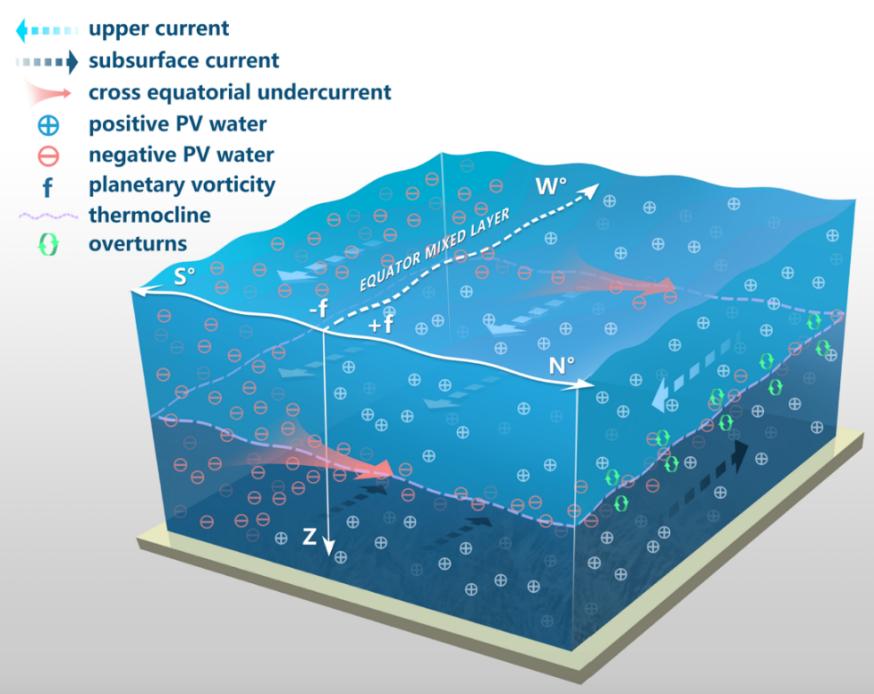Mixing in the ocean is a poorly understood process that is recognized to be significant to climate. A fundamental question of recent interest is whether large ocean currents, like the Gulf Stream, the Kuroshio, can contribute to mixing, the answer to this question promises to greatly increase ability to build realistic mixing into ocean models, thereby improving climate prediction in this era of climate change.
Recently, an international research team led by Dr. ZHOU Hui from the Institute of Oceanology of the Chinese Academy of Sciences (IOCAS) provided the first observational and numerical evidence of the existence of key mixing pathways that exist far beyond the ocean's surface and known boundaries.
The study was published in Communications Earth & Environment.
Researchers revealed enhanced dissipation caused by symmetric instability in the northwestern equatorial Pacific thermocline based on direct microstructure measurements and high-resolution numerical modelling.
The enhanced subsurface cross-equatorial exchange provided the anticyclonic potential vorticity needed to drive the symmetric instability, which suggested a new route to energy dissipation for large scale currents and hence a new ocean turbulent mixing process in the ocean interior.
The key recognition of the study is the critical role played by the equator, and the exchange of water across it, that for dynamical reasons opens the pathways in a rather general way.
"We have observed the symmetric instability in the western equatorial Pacific thermocline, but there is little reason to expect it can't happen anywhere near the equator," said ZHOU Hui. "And, since the equatorial ocean occupies a vast area of the ocean, this as a mechanism is possibly of broad significance. Finally, our results, coupled with those of a previous study in the same region, hint at a connection of this process to different ocean states associated with El Nino-Southern Oscillation (ENSO)."
This work is also a typical illustration of the importance of observation, which inspires the recognization of a natural-sourced force in driving the mixing that though to be an external force by theory.
Dr. ZHOU Hui is first author of the study, Prof. William Dewar from Florida State University, and Dr. CHEN Xu from Florida Agricultural Mechanical University are co-corresponding authors of this study. Other contributors include researchers from Pilot National Laboratory for Marine Science and Technology in Qingdao, Beijing Institute of Applied Meteorology, State Key Laboratory of Geo-Information Engineering in Xi'an, Laboratoire de Glaciologie et Geophysique de l'Environnement, and Scripps Institution of Oceanography.
This study was funded by the Strategic Priority Research Program of the Chinese Academy of Sciences, National Natural Science Foundation of China, the National Science Foundation, and the French Ministry of Research.

Field operations of a free-falling microstructure profiler in 2017 on the R/V KEXUE on the NSFC Western Pacific Ocean Open Research Cruise

Schematic diagram of the generation of subsurface symmetric instability induced subsurface turbulent mixing in the equatorial ocean thermocline
Zhou*, H., Dewar*, W., Yang, W., Liu H., Chen* X., Li R., Liu C., G. Gopalakrishnan. (2022). Observations and modeling of symmetric instability in the ocean interior in the Northwestern Equatorial Pacific. Commun Earth Environ, 3, 28.
ZHOU Hui
Institute of Oceanology
Email: zhouhui@qdio.ac.cn
(Editor: ZHANG Yiyi)
|
|

Address: 7 Nanhai Road, Qingdao, Shandong 266071, China
Tel: 86-532-82898902 Fax: 86-532-82898612 E-mail: iocas@qdio.ac.cn


